Shanghai Tour 12 - Oriental Land (东方绿舟)
- Jinwook Chang
- Feb 23
- 7 min read
Explore the intersection of hands-on science and expansive green space on this adventurous cycling route through Qingpu, from interactive exhibits at Xi Cen Science Center to the vast lakes and global landmarks of Dong Fang Lv Zhou (Oriental Land).
Total Distance: 20 km (82.8 km personally) | Total Hours: 8 Hours (Heavy Biking, Heavy Touring)
Main Destinations:
Xicen Science & Technology Innovation Center (西岑科创中心)
Oriental Land (东方绿舟)
Map:
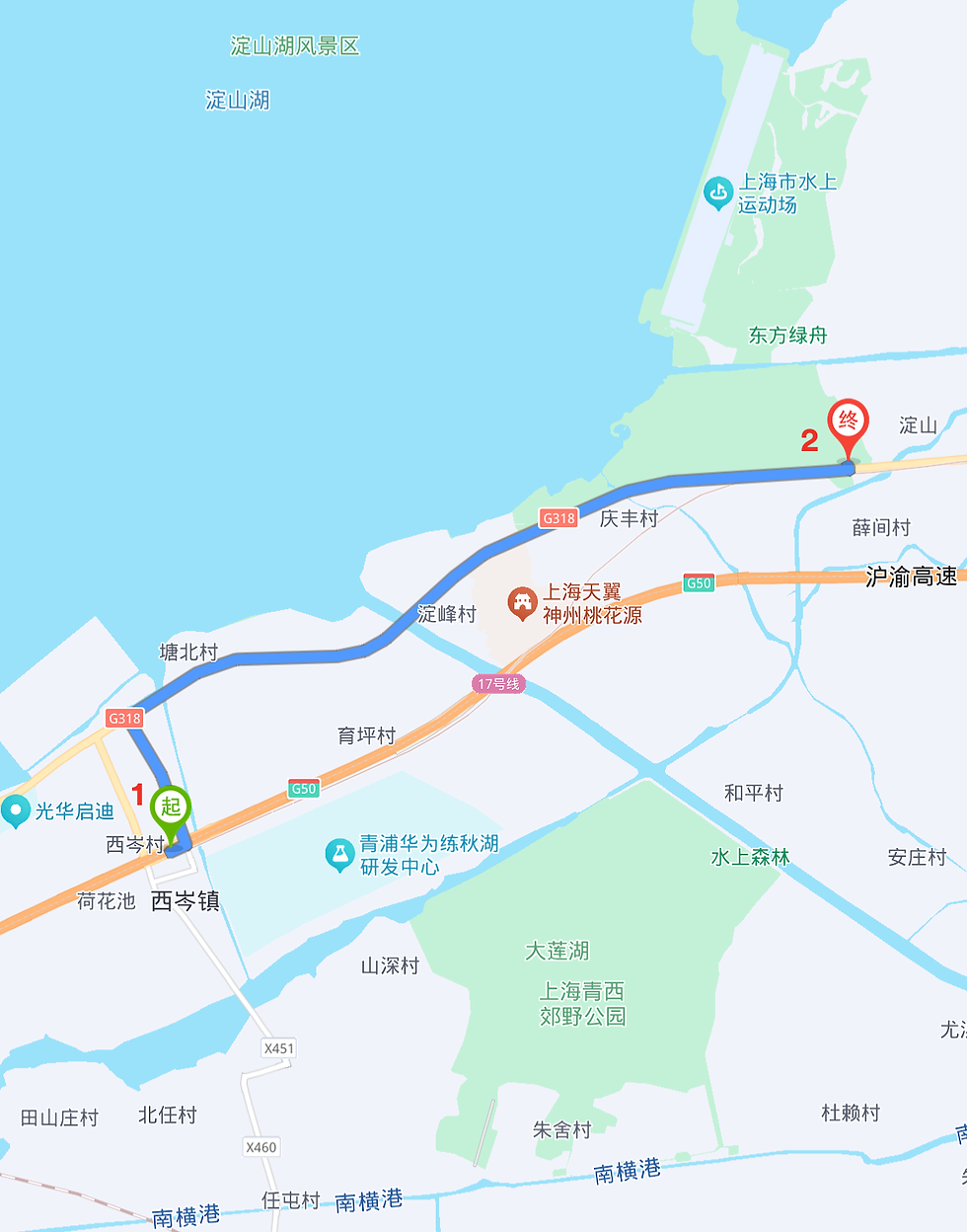
Main Blog:
On February 22nd, the Bike in Shanghai group set out on its 12th trip through the western Qingpu District, exploring the Xicen Science & Technology Innovation Center and the Oriental Land.
Xicen Science & Technology Innovation Center (西岑科创中心)
The Xicen S&T Innovation Center is a major tech-oriented development in Jinze Town, Qingpu District, Shanghai. Envisioned as a world-class “science‑town”, it integrates R&D, commercial services, and community living into a green, waterfront urban framework.
After biking approximately 40 km, we arrived at the Xicen Science & Technology Innovation Center—the newly developed hub for R&D labs in Shanghai.

The eastern section of the Xicen Science & Technology Innovation Center is centered around Huawei’s massive Lianqiuhu R&D campus. You can’t go inside, but even from the gate, you get a sense of how big and important this place is. It’s quiet, clean, and tightly secured—no photos allowed. The buildings are modern and low-rise, with trees and carefully maintained landscaping around the entrance. The area feels more like a private tech zone than a public space.
This part of Xicen is part of a bigger plan to build a “science-town” that combines research, development, and city infrastructure. Even though a lot of it is still under construction, it’s clear the focus is on tech companies and innovation, not tourism. The wide roads, new metro station, and empty plots show how fast the area is changing. It’s not a place you explore for fun, but it’s interesting to see how Shanghai is expanding its tech industry into the suburbs.
I tried to get into the place, but the guards stopped me from doing so, requiring some kind of QR code on my phone. Moreover, the pictures above show a small red train that goes around this town, which makes it seem more like a mysterious cutting-edge tech society, like ones you would see in 2050. Surrounding the area are buildings and construction sites—some of which seem to have finished, some of which seem not to have. However, other than the crowd from the subway station to the science & technology center, there aren't many people around, so it also gives off vibes of a ghost town.
After a short look around the center, we headed to our main destination—the Oriental Land.
The Oriental Land (东方绿舟)
Dong Fang Lv Zhou is a massive outdoor education base in Qingpu, Shanghai, featuring lakes, sculptures, and exercise zones designed for youth activities and public recreation.
This is the main gate of the Oriental Land, marked by a wide open plaza, tall water fountains at the center, and a large rock wall in the back with the bright pink characters “东方绿舟” perched above it. Surrounding the fountain are neatly trimmed green hedges spelling out motivational slogans in white characters, often used in Chinese public education spaces. Behind the stone wall is a dense forested area that stretches throughout much of the park, offering shade and greenery for visitors. The whole area feels clean, structured, and symbolic—built not just for leisure, but to inspire discipline and unity, especially for youth programs and school trips.
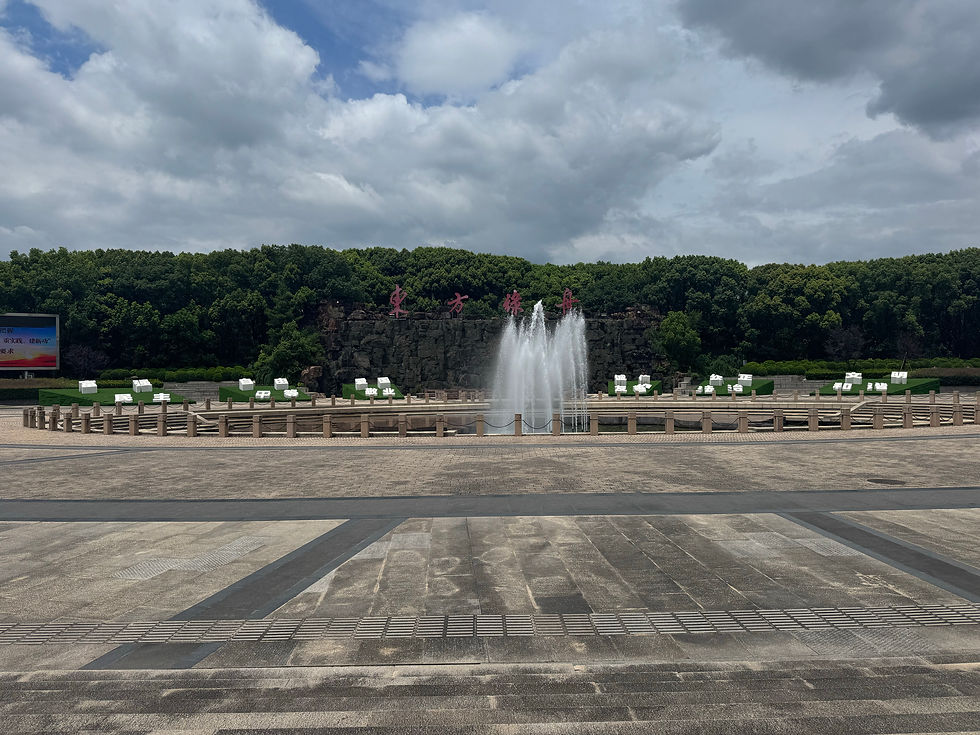
The park requires a ticket, which costs 50 RMB for adults and 25 RMB for students.

As you enter through the main gate, you see the map of the oriental land on the left, as shown in the picture above. We went around the park along the route for this trip.
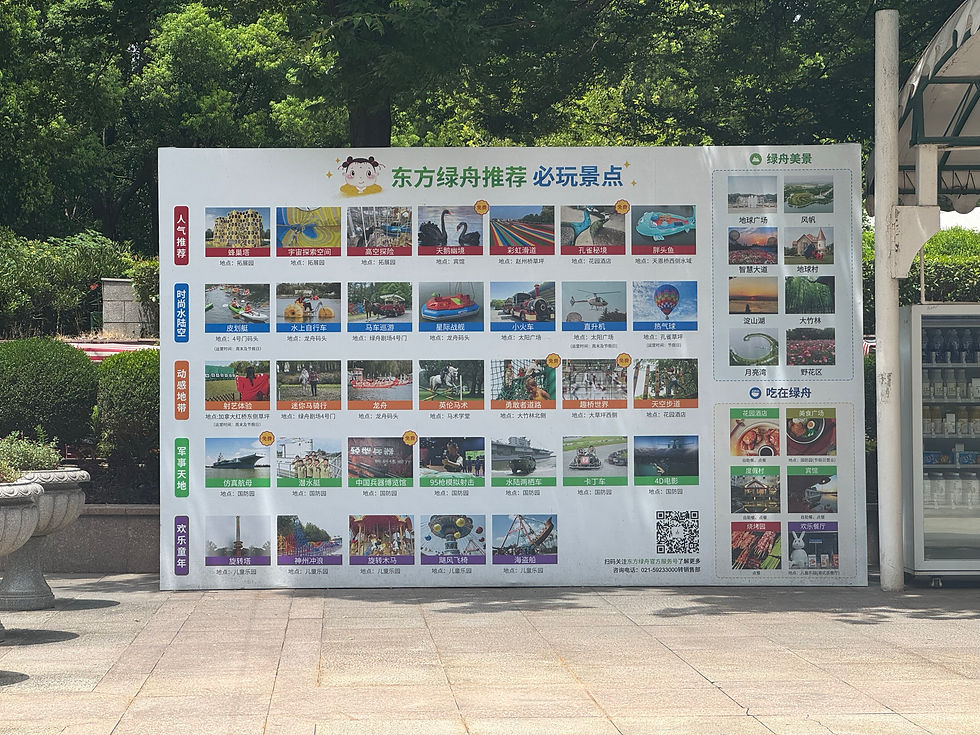
Right past the entrance, you'll find a massive display board highlighting the must-visit attractions across Dong Fang Lv Zhou. The park is divided into themed zones that blend education, physical activity, and entertainment. Popular spots include water activities like paddle boats, water walking balls, and spinning water disks, alongside dry-land favorites like the rainbow slide, honeycomb maze, jungle zipline, and forest train. There’s also a hands-on challenge area with high ropes, rock climbing, archery, horseback riding, and tree-top obstacle courses—perfect for youth camps and team-building programs.
In addition to physical activities, the park features a large military experience zone with model tanks, missiles, and warships, plus flight simulators and hot air balloons in the aviation section. Families and children can enjoy a mini amusement park with pirate ships, Viking boats, and merry-go-rounds. Scenic spots like the central fountain, rose garden, sculpture lawn, and bamboo grove make for peaceful breaks between activities. Food courts and themed cafeterias are spread across the park, offering quick snacks and full meals, rounding out a full day of learning, playing, and exploring.
Moreover, since there are so many outdoor activities here, there is also a resort and a hotel in the park, so if you accompany a child, you may consider staying a day or two here since the park is just too large to go around and enjoy all the attractions that the park has to offer.

In the park, you are not allowed to bike, so we had to walk around instead. The park lends four-person person bikes and golf carts, but they were out of our budget. I remember the golf carts costing more than 200 RMB while the four-person bike cost somewhere between 50 to 100 RMB per hour.
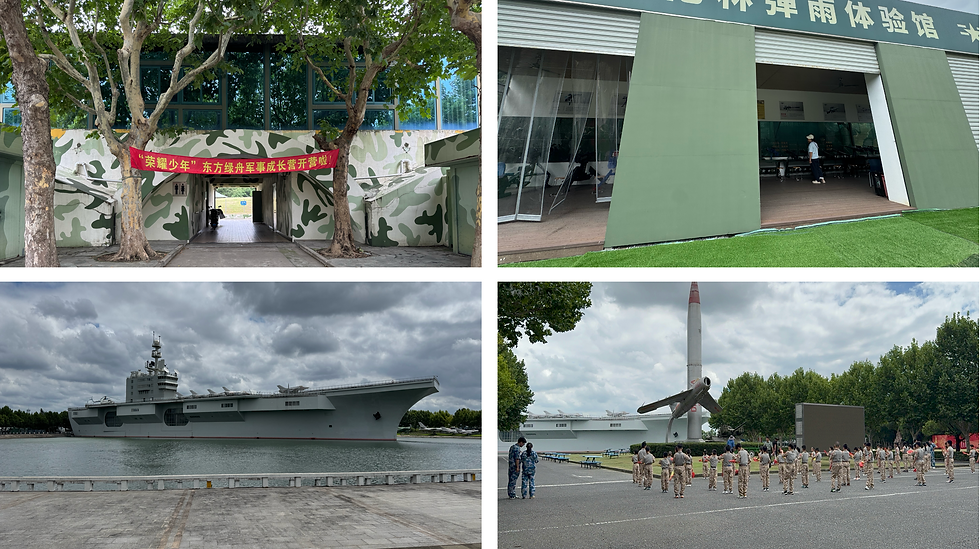
Walking around the park, we encountered a military park, where we also saw young children in a national camp, singing the national anthem and training martial arts. Here we spotted retired fighter jets and a missile installation, set up as part of an open-air military display. Rows of children in uniform practiced drills on the square while instructors in digital camouflage gave commands. The whole area felt like a mix between a training base and an interactive exhibit—part patriotic education, part outdoor museum. It was clear this zone wasn’t just for sightseeing but for building discipline and national pride among youth through physical training and immersive simulation.

The most striking sight was the life-sized replica of a Chinese aircraft carrier floating in the artificial lake—massive and detailed enough to feel real from a distance. Inside the aircraft carrier was a military museum, featuring China's tanks, military cars, communist ideologies, and many more. If you are a military enthusiast, this is a must-visit destination.
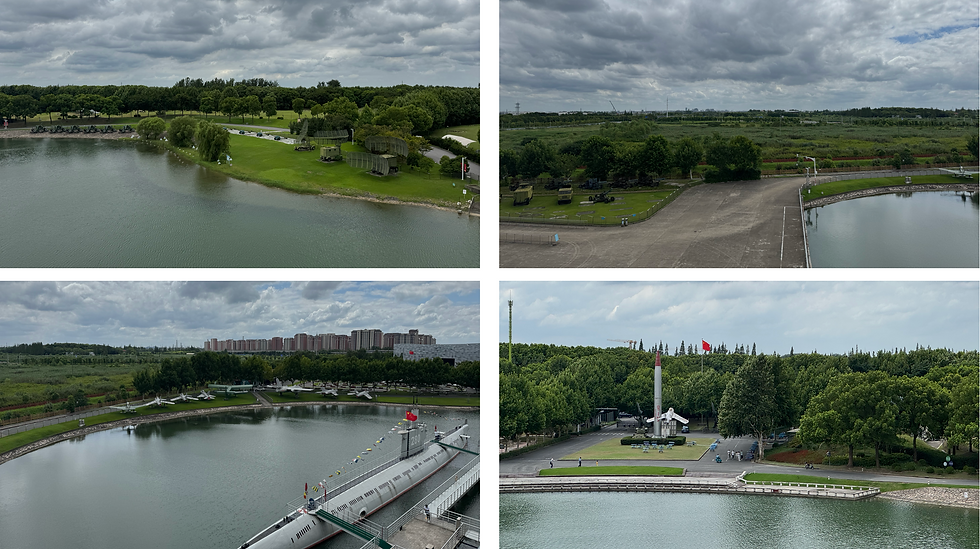
The aircraft carrier consists of three floors, and on the top floor, you can see the whole military park and beyond. From up there, you're surrounded by vast green fields, dense tree lines, and clusters of willows gently hanging over the lake’s edge. Military tanks, planes, and rocket launchers are spread out across large lawns and pathways, but what stands out most is how spacious and quiet the area feels—almost more like a nature reserve than a military exhibit. Neatly mowed grass, rows of shaded walkways, and patches of open space blend with the distant wetlands, creating a balance between natural scenery and the mechanical displays below.
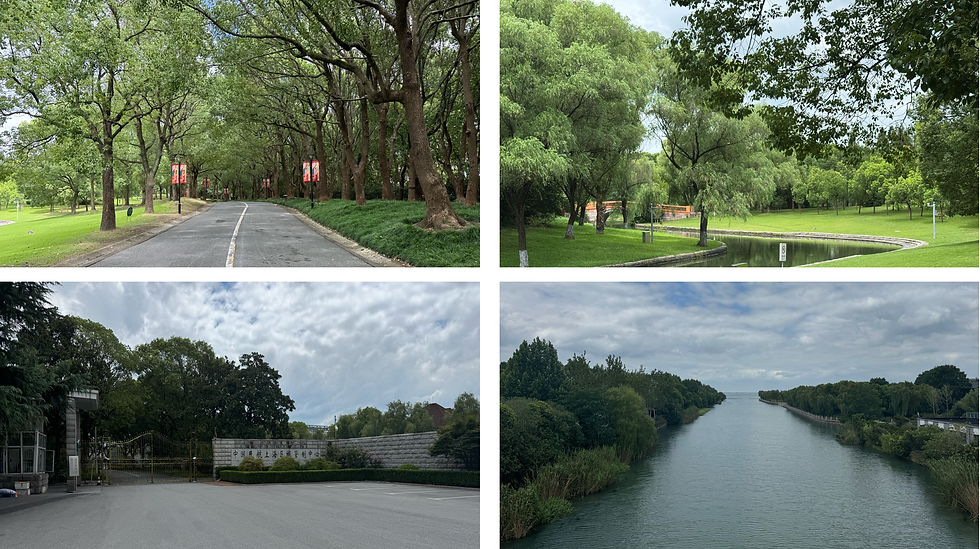
As you walk deeper into the Oriental Land, you follow a tree-lined road surrounded by thick canopies and neatly trimmed grass on both sides. The path winds past small ponds, quiet lawns, and weeping willows, giving the area a peaceful, park-like feel far removed from the busier zones. Eventually, you reach a calm river that stretches endlessly toward the horizon, bordered by lush greenery and walking trails.
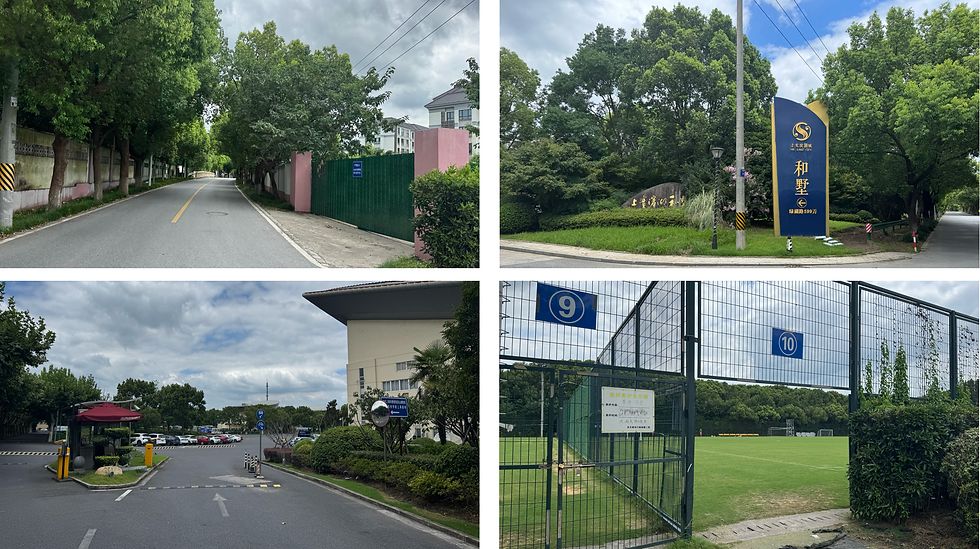
As we arrived at the end of the Oriental land park, tired of walking for so long, we hopped on rental bikes to explore the neighborhood on the north side of the park. Over here were mostly luxury houses, extremely big, looking more like a weekend house for the rich rather than where people actually lived. There were many houses around, but people were rarely spotted.
There was also a sports school on the north side of the Oriental land, where Chinese athletes train for international competitions. As you see in the photo above, we were able to get a snap shot of the soccer pitch outdoors, but we were not permitted inside. Since we visited around lunch time, not many athletes were spotted outside training.
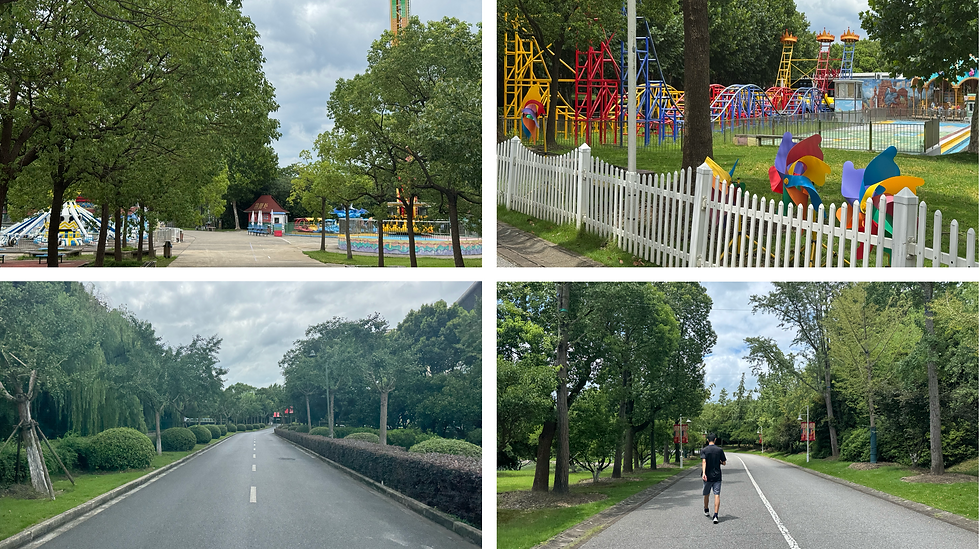
After returning to the park, we saw a small amusement park, ideal for younger children in elementary or middle school to enjoy. Each ride costs around 30 RMB once, but you do get the privilege to enjoy the ride all on your own.

Walking towards the west of the oriental land, we encountered the Dianshan Lake (淀山湖). Dianshan Lake (淀山湖) covers an area of approximately 62 square kilometers, with an average depth of 2.1 meters and a maximum depth of around 6 meters. It holds about 130 million cubic meters of water and sits at an elevation of just 3.3 meters above sea level. As Shanghai’s largest natural freshwater lake, it plays a key role in regional water storage and flood control, and also serves as the origin of the Huangpu River. It’s known for its calm waters, scenic walking and biking paths, and serves as the source of the Huangpu River. The lake is a popular spot for boating, camping, and weekend getaways.
Across the lake, on the top left picture, is Suzhou city, while the lake on the top right picture is Kunshan city. Sam and I tried to take a photo here, but the sunlight was so strong we couldn’t keep our eyes open—haha.
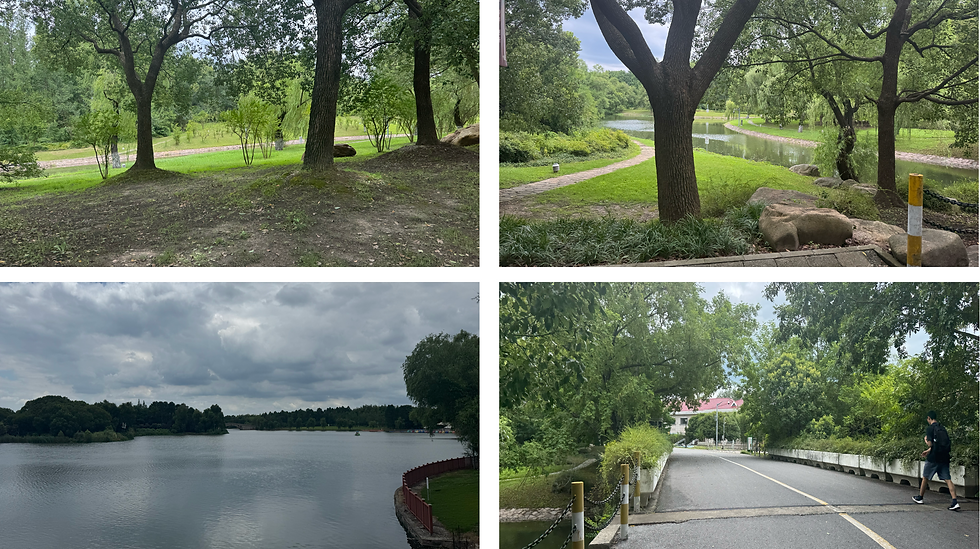
Walking back to the main gate in this weather to retrieve our bikes was tough, but the surrounding trees and greenery helped cool us down. Since it was either too hot or too expensive, we ended up skipping several attractions like horseback riding, water activities, and the jungle gym. There are restaurants inside the park, but I recommend eating outside at a higher-rated spot listed on China's version of Yelp.

We finally arrived at the main gate/exit and were ready to cycle back 30 km in the scorching hot weather. Overall, it was a great experience coming here, as I always enjoy walking in parks, but the Oriental Land may be a little too big to explore everything on foot. Despite its high prices, if you are accompanying someone who may potentially complain about the hot weather, especially walking around during summer, I suggest you either rent a golf cart or a bicycle around the park.
This marks the end of our 12th Shanghai tour, and I hope you all enjoy it as much as we did. As always, stay tuned for our bimonthly trip updates!




Comments